Considering hiking the Otter Trail on the Tsitsikamma Section of the Garden Route National Park? Don’t consider it. Book your trip now on SANPARK’s web page!
I’ve hiked the trail 4 times during winter (2012-2015) and I’m already booked for my 5th hike in May 2016. In prior years I felt that I could never do justice to blogging about this extraordinary experience. Herewith my humble attempt to the ultimate guide. To read about each day in detail click here.
About the 5 Day Hiking Trail
The Otter trail is a 42k.5m trail that is hiked over 5 days / 4 nights from Storms River in the Eastern Cape to Nature’s Valley in the Western Cape, South Africa. The Bloukrans river is a natural border that separates both provinces.
Officially opened and inaugurated in 1968, the Otter Trail is the oldest hiking trail in South Africa. It is named after the elusive otter which some hikers may be lucky to glimpse.
There are 2 huts at each campsite that accommodate a maximum of 6 people each on bunk beds. This means that a maximum of 12 people are allowed onto the trail each day.

The minimum recommended age is 12 years (with a parent / guardian) and maximum age is 65 (unless a doctor’s note is supplied).
People generally form groups of 6 or 12 people and occupy one or both huts. However, I’ve had 2 friends who booked with a number of smaller groups who they met for the first time on the trail. They said that there was even a German guy in their group who had joined alone. The SANPARKS booking site shows you the number of free spots / beds available per departing day. If you only book for 11 people in your group, there is a chance that some stranger that you don’t know could book that final bed. Be welcoming to that person – nobody should hike the trail alone, especially at the river crossings. If you can, try to include a doctor or medic in your group.
Getting there
There’s no airport at the start of the trail in Storms River. The most popular way is to fly into the closest airport and hire a car or shuttle to get you to Storms River.
The distances by road from the most popular airports nearby are:
- Plettenberg Bay Airport – 74 km
- George Airport – 166 km
- Port Elizabeth Airport – 195km
- East London Airport – 460km
- Cape Town International Airport – 568km
CemAir is the only airline that flies into Plettenberg Bay airport from OR Tambo (Johannesburg) International Airport and Cape Town International Airport. Note, they don’t fly on every day of the week. See the flight schedules here
I’ve flown into Port Elizabeth Airport in the past, hired a car and driven to Storms River.
However we prefer flying to George Airport (on Kulula or SAA), and amongst a group of 12 of us we book a shuttle transfer and rent 1 or 2 cars amongst the entire group. We’ve always used Gecko Tours and Transfers in George to transfer us each way. It helps to have 1 car parked at the start of the trail in Storms River and the other at the end of the trail in Natures Valley.
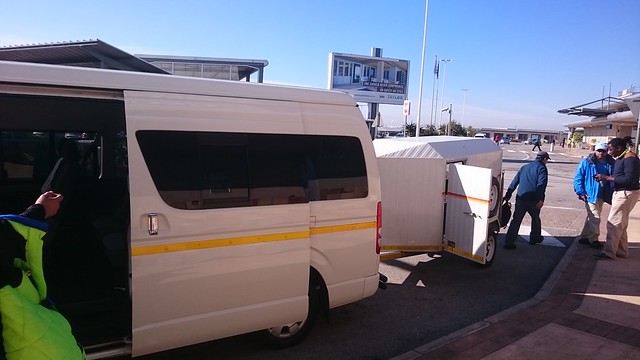
If we’re also booking a shuttle why hire a car?
- We like to keep a change of clothes in the car to change into after hiking the trail, before boarding our flights home (for our benefit, and the benefit of other passengers around us. Your hiking clothes will be filthy after 5 days).
- Unforeseen circumstances – We always have team members exiting the hike earlier than expected for any number of reasons, including injury and bad weather / tides. I exited on Day 4 this year after the Bloukrans river was unpassable. I could have re-joined at camp 4 (by ranger drop-off) but this year I felt like chilling in Plettenberg Bay for a night before heading back home. Having a car gives you the freedom to move around if you’re stuck.
Gecko Tours and Transfers will allow you to leave a change of clothes in a sealed and labelled pack on their shuttle. They’ll bring it to you just before they collect you for your airport drop-off. By leaving our gear in the cars, we have access to it sooner (with enough time to shower at the end of the trail).
If you live in Cape Town, you may consider driving to Storms River as some of our friends have done.
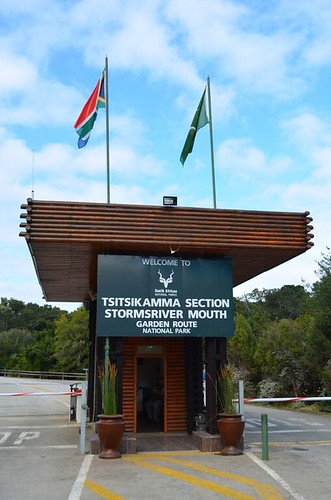
We generally arrive at Storms River by 2pm on the day that we start hiking and leave for our home cities from Natures Valley on the final day by 1pm in order to catch our flights home from George. You should not start the first day’s hike after 3pm (in winter) as it means that you’ll only reach the campsite after sunset.
Training
The Otter Trail isn’t like a walk in your local Botanical Gardens. It helps to train before you embark as this will make your hike more enjoyable. Being active at gym, running, cycling and swimming helps. What you need to ensure is that you include inclines such as stairs into your training regimen. The Otter Trail is full of ascending and descending staircases so it helps to practice walking on multiple flights of staircases at least 6 weeks before your hike. In Johannesburg we trained on the famous Westcliff staircases on many occasions. Other useful activities are the Athletic Step aerobics class offered in local gyms, lunges, calf stretching and squatting.
What to pack
The general guideline is for your backpack to weigh no more that 20% of your body weight. In winter, our backpacks weigh between 10 and 14 kg in general (with water).
Outdoor Warehouse:
- 2 pairs hiking socks (1 spare if the other gets wet, or if you would like to wear 2 layers at the same time for further cushioning)
- Microlite towel
- Sleeping Bag (minimum 1 degrees Celsius extreme rating, 7 degrees comfort e.g. Capestorm Microcore 130)
- Buff – it’s cool but not necessary
- Trekking poles (minimum 1. It helps to have 2 poles on day 2 & 3 of the trail)
- Survival bag + cable ties / duct tape (Put your bag in this during the river crossing)
- If you have a light raincoat you should take this (it’s better than a poncho which can tear under your backpack)
- Biodegradable toilet paper
- Water purification tablets
- Pocket soap (soap leaves or small soap liquid bottles)
Additional items for winter:
- Sleeping bag liner (it adds more warmth and you just wash the liner, not the bag afterwards)
- 1 pair normal socks – to sleep in at night if it gets cold.
- Beanie
- Thermal vest and pants – keeps you warm at night
Columbia shopping:
- Hiking jacket and long pants (for winter)
- Hiking boots – (Consider getting one size larger than your everyday shoes. Make sure you wear in your hiking boots a bit before hiking the Otter Trail).
Mr Price Sport shopping:
- Aqua shoes (to wear during river crossings) or enclosed sandals
- Spork set (plastic spoon/fork)
- Basic headlamp (at least 3 LED. The Energizer headlamp is good. Mr Price Sport’s Trail headlamp is okay).
You will also have to carry:
- Cap
- 1 swimming costume
- Dri-fit shirts (no cotton! – it’s heavy when wet and never dries in Winter). Minimum 2 (one for the day, one to sleep in at camp. These shirts are light so I don’t mind carrying 4).
- Shorts (summer) or Track pants (winter) to sleep in / wear at camp
- Plate (I prefer to carry a plastic lunch box)
- Mug – you can get one of those camping mugs from Outdoor Warehouse or Pick and Pay.
- Extra Large sized zip locks – helps to put each days snacks in a bag of its own.
- Toothbrush & Toothpaste
- Underwear
- Lots of packets / compression sacks – to split and put your clothes in (the backpacks main opening is at the top. To get something from the bottom you generally need to empty the entire bag. It’s easier to do when everything is wrapped within smaller packs.)
- Bin bag – I always line the inside of my backpack with a bin bag. Everything goes into this. If it rains, the contents of my backpack won’t get wet. You can also carry a rain cover for your backpack, but I prefer the simple bin bag method.
- Either a Hydration pack or 2 x 750ml water bottles
- Sunblock, mosquito repellent, sunglasses – (only in Summer)
Click here to view & save an image copy of the gear list (to view/share on a mobile device)
Personal Medical / Safety items
- A basic first aid kit (with band aids, disinfectant – very important!)
- A space blanket (under R20 at Clicks)
- Immodium
- Pain killers or Anti-inflammatories if you feel that it is necessary
- Gaviscon / heartburn medication
Click here to view & save an image copy of the personal medical / safety list (to view/share on a mobile device)
Communal items (per group of 12)
- 5 gas stoves
- 1 camp kettle (heat water on the braai stand)
- 5 gas canisters
- 1 Fire tong
- 1 or 2 boxes of firelighters (in Winter we braai meat on 3 nights and need up to 2 boxes)
- 2 pans
- 3 pots
- 1 knife (for the Braai Master)
- 1 x 30m rope for the Bloukrans river crossing
- 1 gas lantern per hut (nice to have)
Click here to view & save an image copy of the communal items list (to view/share on a mobile device)
Personal food list:
Breakfast – Instant Cappuccino, Cereal Bars, Jungle Oats so Easy and Future Life sachets. Mini-Yogurts also last for days in your backpack during winter
Lunch – Rye bread, Tortillas or Salticrax/TUC biscuit with Nola Chicken Mayo spread or John West Tuna sachets
While Trekking: I also like carrying an apple a day, M&M’s, Lunch Bars, Snickers and Trail Mix (I like the On The Go brand which is available at Clicks and various supermarkets. I don’t like the Safari brand).
Get yourself Game / Amelia / Tang flavored powders to mix with the potable river water that you collect during the hike (and mix with water purification tablets)
Supper – Depending on the season, you may be able to braai food for 2 or 3 nights.
We have one team member who organises the communal food for the entire group.
The default options are:
- Night 1: Vacuum sealed chicken fillet and dehydrated rice (dehydrated veg biryani)
- Night 2: Vacuum sealed sausages and Smash
- Night 3: Vacuum sealed Minute Steak and Pasta or tortillas
- Night 4: Pasta or dehydrated rice (veg biryani). You could mix it with Tuna for protein
This meat is frozen and distributed to the rest of the team on the day we embark on the hike
In addition, each person can also bring:
- Cup A Soup
- Any personal delights (It’s nice if each person in the group brings some unique luxury food to share with the rest of their group – e.g. milk for tea, Coke, biscuits, chocolate slabs, pancake mix, eggs)
Click here to view & save an image copy of the food list (to view/share on a mobile device)
What not to pack
We had a friend whose backpack weighed 21kg. Within it he brought Tupperware’s with pre-made steak sandwiches and pre-made chicken and mayo sandwiches.
There is a scale to weigh your backpack in the Otter Hut at Storms River.
He also had a half kilo of cashew nuts, a half kilo of sweets, half almonds, 1 loaf of rye bread, a large bottle of Tabasco, a large sachet of Nando’s Perinaise, a large packet of Doritos, a small tub of peanut butter, a hot water bottle to sleep with in winter, 4 perfumes and a heavy-duty thick winter jacket. This was in addition to the items in the personal gear and food list above. He managed to carry everything and all the food did get eaten, but it’s not advised to pack like this.
Solar power chargers and pocket shower sets haven’t proved to be useful on our trips.
Facilities
There are 4 overnight campsites with 2 huts that have 6 bunk beds each, with comfortable mattresses.
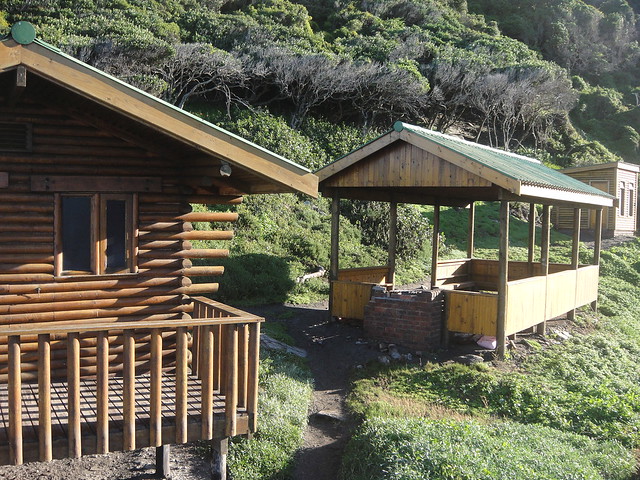
Each campsite has 1 flush toilet and 1 shower (cold water)
Wood is generally available under the first hut at each campsite for you to use in the braai area (don’t waste it)
Cell phones and Electricity
There is no electricity anywhere on the trail or at the campsites
Cell phone reception is not available throughout most of the trail. You may get reception on some of the plateaus after a steep climb on each day. We also had reception on Day 3, walking alongside the ocean just after departing the campsite, and at the Night 4 campsite.
Power banks are handy to recharge your phones or cameras (that can be charged via a USB port)
When to go (Season, Tides, Moon Phase)
You can choose whether you want to hike the trail in the warmer or the colder months.
In the warmer months:
- You can spend more time swimming in the beach and rivers.
- There’s more daylight available so you can enjoy more time on the trail before reaching the campsites.
- You can get away with less clothing (no need for thermal underwear, fleece jackets. Etc)
- There’s a risk that you may encounter snakes (Puff Adder, Rinkhal and Cape Cobra are indigenous to the area). And be in the company of other creatures…
In the colder months:
- The water is chilly. You can dip into it but long swims aren’t always enjoyable.
- You hardly see any bugs. No mosquitoes or snakes.
- There is always a rush to be at camp by sunset (which is earlier) to get the fire started, shower and dress warm before the temperature drops.
- No need for sunblock or sunglasses.
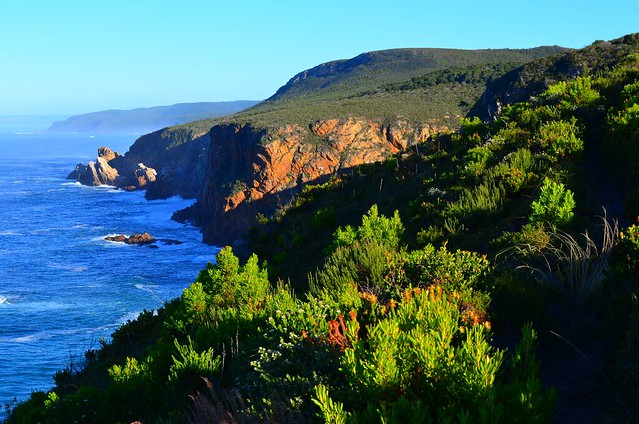
If you’re concerned about the tides, you can check this page for the tide charts (it’s for Plettenberg Bay which is close to Tsitsikamma).
Manipulate the Month and Date on this url http://www.kwathabeng.co.za/tides/Plettenberg-Bay-tides-Dec-2015.html#gsc.tab=0 for the month that you are planning to visit.
Pay special attention to which calendar days will be your 3rd day (Lottering River crossing) and 4th day (Bloukrans river crossing) and check the low tide times. You’ll need 3.5 to 6 hours to reach the Lottering river and 4 to 5.5 hours to reach Bloukrans from the campsite.
Also see what phase the moon will be in when you visit. We hiked during a new moon phase this year and had a brilliant night sky that was full of stars to stare at in awe each night.
Safety and Precautions
Stick to the trail and don’t take any shortcuts. The rangers always tell us that this is the main reason people get injured.
I was quite foolish by trying to take a shortcut onto Elandsbos beach this year. At some point I slipped on the rocks and fell backwards onto my backpack. My elbow hit a rock and I had a small bruise with bleeding. I also lost my cap to the Indian Ocean, and my hiking boots got soaked. Thankfully I line the inside of my backpack with a bin bag so none of the contents got wet.
When packing your backpack, the general guideline is to have your sleeping bag at the bottom, heavy items in the middle and light items at the top. A friend packed heavy items on the top and fell forward onto his forehead when scrambling on the rocks on Day 1.
Don’t hesitate to take the Emergency Exit. You don’t have to prove anything to yourself or others whilst hiking on the trail.
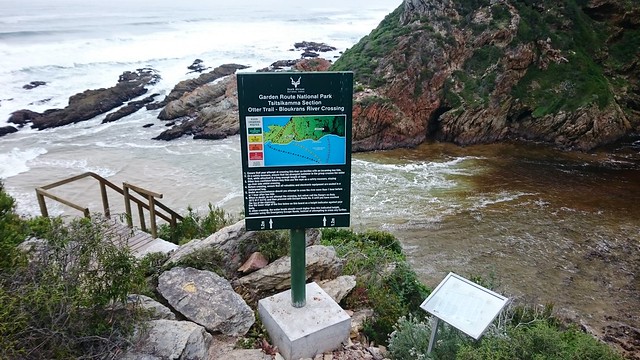
On our 2015 hike only 3 members of our group managed to cross the Bloukrans river. We were there 20 minutes after low tide. One of our group members had to let go of his bag as he was swept by the tide about 20 meters upstream whilst attempting to cross. We managed to retrieve the soaked bag later, and after placing call to the rangers, we managed to get the bag up to the emergency exit with the rest of our team.
I’ve hiked the trail 4 times and we’ve always had to call the rangers for early exits for some reason. Be careful, know your limits and don’t take unnecessary risks on the trail.
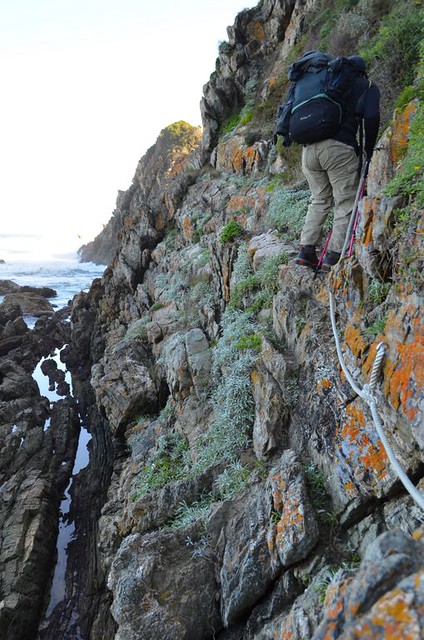
Always make sure you have the emergency number for the rangers and have a cell phone with some remaining battery life to make the call (where cell reception is available) in case of emergency.
Keep a basic first aid kid easily accessible (e.g. on the outer pocket of your backpack).
After a river crossing don’t walk too far with your wet aqua shoes. 2 Of my friends ended up with purple toe nails and blisters after walking about 3 km’s on day 4 without their proper hiking shoes.
And finally, hike in small groups. Never let the last person at the back of the pack hike alone.
Cost and Reservations
Check out this SANPARKS web page for the latest tariffs, to check availability and make a reservation for the Otter Trail hike.
Points of Interest around the Otter Trail
If you’re spending a few days near Tsitsikamma before or after hiking the Otter Trail here is a list of recommended places, activities and restaurants. My friends and I prefer to spend a night in Plettenberg Bay after the hike to recuperate and “dine like kings” before returning home.
Activities:
- Go on a canyoning adventure near Plettenberg Bay with Africanyon River Adventures. This activity is at the top of my list before my next Otter Trail hike.
- Swim with the Cape Fur Seals near Plettenberg Bay with Offshore Adventures
- Glide across the Tsitsikamma forest from above with Tsitsikamma Canopy Tour.
- When we exited the Otter Trail on Day 4 (on my 4th hike of the Otter trail), we were brought to the Cliffhanger restaurant which is beside Face Adrenalin and a Khoisan arts and craft store
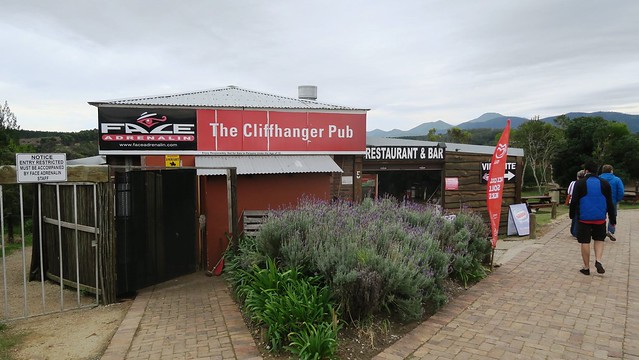
- You can jump off Bloukrans bridge, the world’s highest commercial bungy jumping bridge with Face Adrenalin.

Accommodation
If you’ve arrived a few days before the Otter trail hike, plan to spend a night at Storms River Rest Camp which has comfortable accommodation, a cool suspension bridge, a restaurant and other activities. This is the starting point of the Otter Trail.
If you’ve just finished the trail you can recuperate in Natures Valley Rest Camp. Map location here.
In Plettenberg Bay, 30km’s away we’ve stayed at the following places:
- Driftwood (on AirBnB) – it’s a beautiful home that accommodates 6 to 8 people.
- Tsogo Sun Beacon Island Resort – it’s a little pricey, but this is where you can get pampered..
- Bayview Hotel – This is a great value hotel with comfortable rooms. There’s no breakfast served at the hotel but there are many restaurants outside to choose from. The staff were extremely friendly.
Spa:
If you need a massage after the Otter Trail try to wait until the day after the hike and then visit Jiwu Spa and Salon in Plettenberg Bay. You will probably be exhausted on the day you finish the hike so give your body a chance to recover on its own before visiting this spa.
Food:
- Cornuti Al Mare Pizzeria – delicious pizza and pasta. Go here for lunch.
- The Fat Fish – Situated opposite Beacon Island Resort in Plettenberg Bay this restaurant serves sushi, a variety of surf and turf and delicious desserts. This is a great place to eat dinner after hiking on the Otter Trail. Make a reservation in advance as they’re always busy.
To learn more about what you can expect each day on the 5 day Otter Trail Hike check out this comprehensive article. I hope this guide helps. If you have any questions or recommendations, please leave a comment below.
Credits:
Special Thanks to Yusuf Akoojee, Bilal Randeree and M.H. for use of their images in this article, Batuta Food & Leisure for organising the trips, all my friends for arranging other aspects of the trip (food in particular!) and making it an awesome experience each year, and SANPARKS for maintaining the trail & facilities in excellent condition and providing a high quality service to the hikers




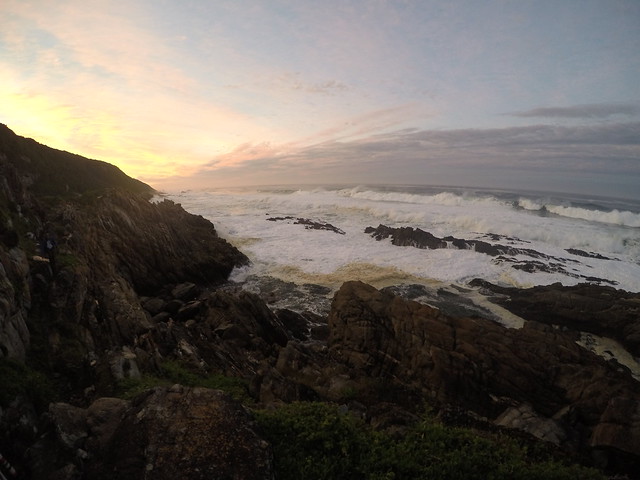
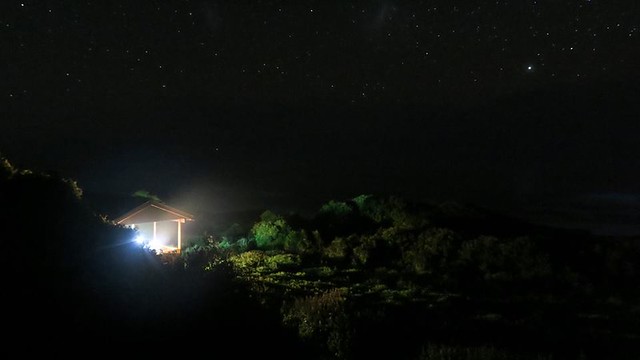
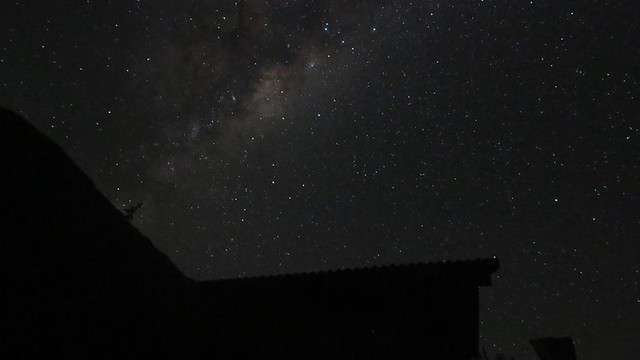
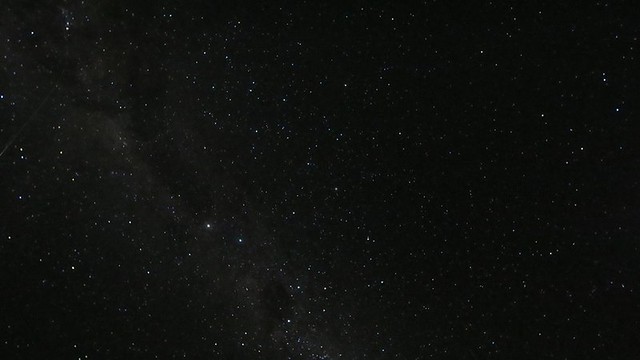

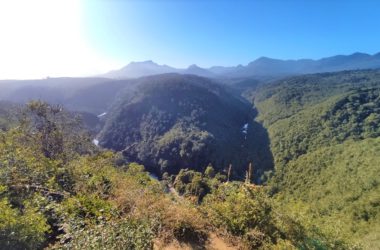
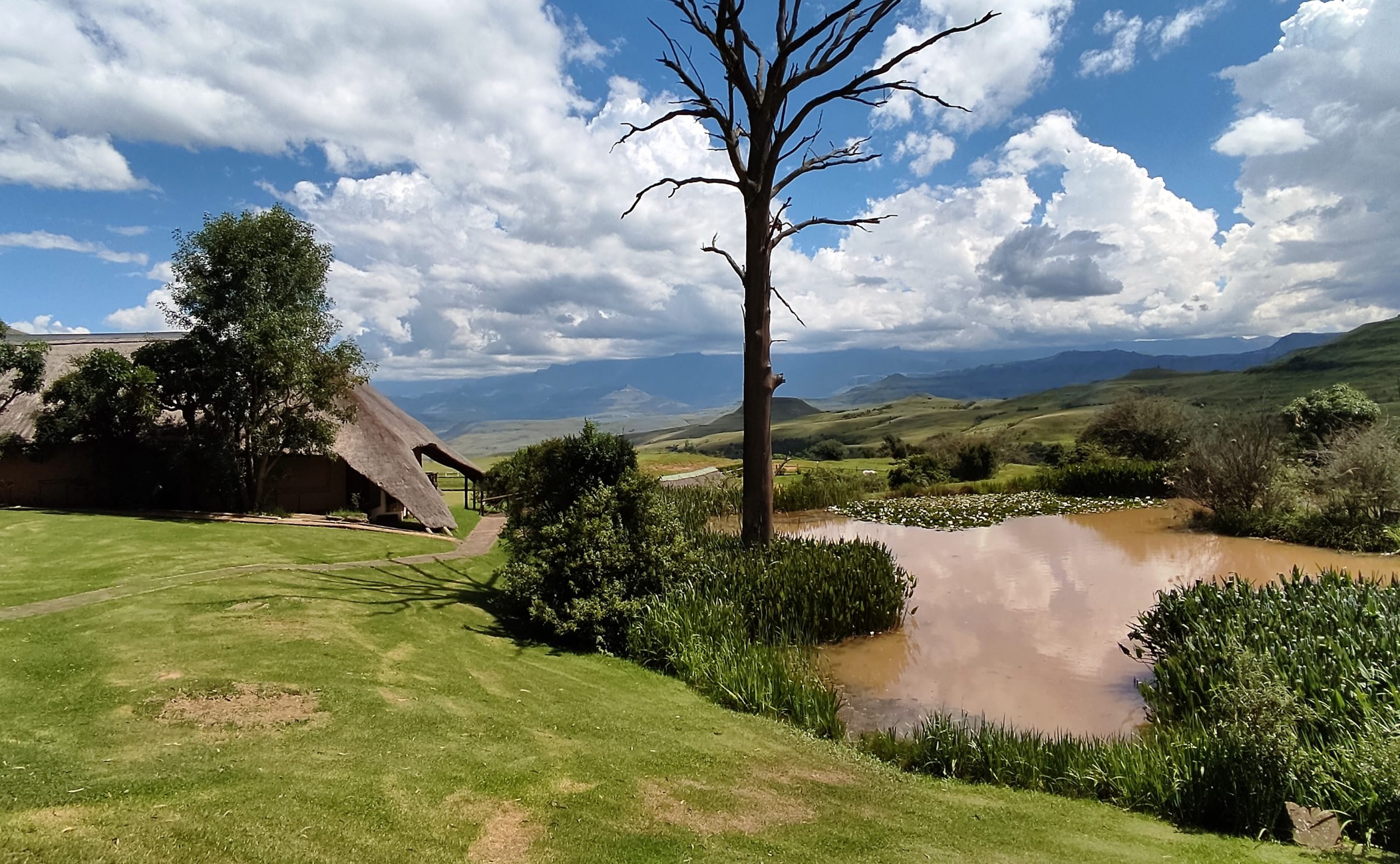

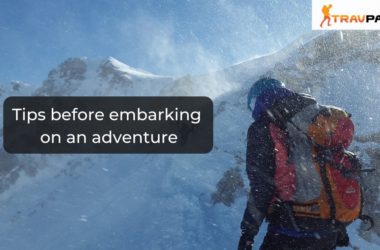
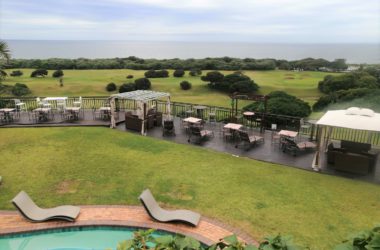
What a wonderful article on what to expect and cater for my first Otter trail.
Thanks Farhad. Expect another awesome article on the trail within the next 2 weeks, with a day-by-day breakdown of the trail
Hi There, my friend and I are just starting our preparation for next year, and I would like to know if you are perhaps doing this next year? We would like to join an experienced group for our first hike.
Thank you!
Hayley
Hi Hayley. Our group for May 2016 is full with a long waiting list. Most of the prep happens before the hike (climb lots of stairs). The rangers will inform you of your river crossing times – make sure you reach at low tide on day 3 and day 4, and stick onto the trail (it’s well marked). You’ll be fine. There’s 12 spots per group and someone else will definitely be traveling with you. You can also ask on the Footprint or Johannesburg Hiking Club group on FB if anyone else is keen to join on your dates.
Also remember that it is totally okay to call the rangers and step out of the trail if there’s any difficulties.
I want to go and do this trail July this year. Do you think My 12 year old son will be able to do this?
Most definitely.
A friend went with his 9 year old daughter.
You just have to keep an eye out for him – no walking off the trail, and carry rope for the river crossing.
If there are any issues, remember that there are plenty of emergency exits – you can get off the trail and rejoin at the next hut with ranger assistance if necessary.
Awesome to have all this info. Really useful and inspiring. I can’t wait – my youngest child is 12 next year so we are almost there. Thank you for all the help in planning. My Mu really wants to come too -she will be 76. Currently doing the Green Mountain trail with her. I wonder if this would be too much??
For a 12 year old it should be fine.
If there are any difficulties, you can exit the trail at multiple points each day.
Thank you for a lovely article. We have booked for the tail in January, but it looks like I need to go to London on business half way through? Can I arrange an early exit? How do I contact ranges and arrange in advance? Do you know the exact exit points? Thanks
Yes. The rangers are extremely helpful and accommodating. On the first day at the registration for the hike you will receive the emergency contact number for the ranger. Do not hesitate to use it. We have previously had team members joining us on the 2nd day of the trail, or people exiting on the 4th. At the emergency exits you will ave cellphone reception to call the rangers – just keep a of phone charged to make that call.
Hi There, can somebody please let me know what is the ideal size of Backpack one can use for The Otter Trail ?
Hi Rajan. 50 to 60 liters should be fine. I carried 60l with winter clothing. Should be lighter in warmer weather
Hi Zaid , I have a fear of extreme heights , have done few hikes up certain trails . Does the otter trail require you to have experience with risky climbs or can one manage by watching and attempting the climbs . Also if I reach a point where I cannot mange can I exit and meet up with the team at camp.
Niyaz Kadiri
Hi Niyaz. Apologies for the delayed response.
It’s quite safe with no steep climbs or rock climbing of any sort. Most of the climbs refer to hiking up or down well maintained stairs that form part of the trail.
There’s just a short distance on a 3m or 4m high ledge that you traverse while holding onto chains, just after the Bloukrans river crossing. Nothing to sweat about. There are multiple exit routes along the trail, and it’s perfectly normal to use them. I’ve hiked the trail 6 times, and probably used an exit route on 3 of the hikes. Because someone else was ill and needed company to exit, or because the river level was too high to safely cross.
Hi Zaid,
Interested to know the exact day you crossed in 2015, when only three made it.
If you had neap and maybe bad weather, then the crossing is the most difficult. We all made it over in that scenario -perfect storm 😉 in 2010, in worse conditions than in your video
cheers
Hi Colin. Just saw your message now. It was 15 June 2015.
3 of our group made it. One lost their bag to the current, but we managed to recover it on our side of the river – was quite a mission transporting a soaked backpack with winter clothing up the emergency route at Bloukrans.